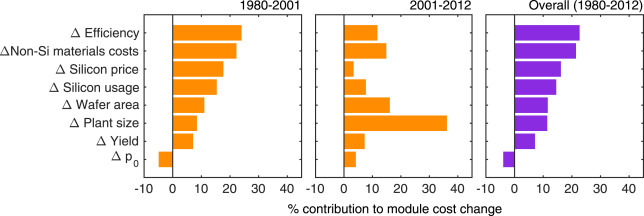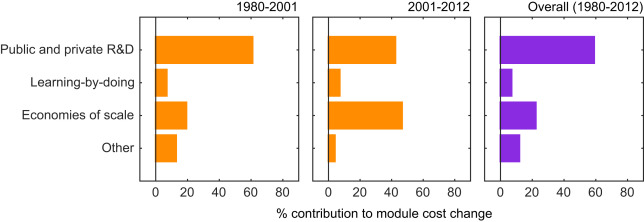
Solar panels are cheap and getting cheaper. A recent study found that the cost per kilowatt-hour of solar has fallen below coal and gas. Even a recent US tariff on Chinese solar cells and modules (the components that make up solar panels) hasn’t been enough to make a dent in the solar industry.
Now, researchers from the Massachusetts Institute of Technology (MIT) have built a model to quantify which factors contributed the most to cost-per-watt changes for solar panels since the 1980s.
The results were that better module efficiency was the number one cause of declines in solar panel cost per watt between 1980 and 2012, with money from government and private research and development contributing to the bulk of those efficiencies. By 2001, however, economies of scale started playing more of a role in solar panel cost declines.
Tracing costs
The researchers note that they’re focusing on cost rather than price in their model, because cost is more reflective of technology changes, and prices often reflect some sort of artificial markup. (Of course, prices often follow cost declines.)
Across the board, cost declines have been dramatic. Recently, the Department of Energy announced that it had reached a six-cents-per-kilowatt-hour cost goal for utility-grade solar, and the department is now exploring paths to five-cents-per-kilowatt-hour costs for residential solar. Recently, researchers tried to find whether a three-cents-per-kilowatt-hour price was reflective of costs in the Middle East. They found that, despite government intervention, the prices were not absurd given recent cost declines.
To analyze how the costs of solar panels changed over the last 40 years or so, the paper splits costs into “low-level” and “high-level” cost changes. Low-level mechanisms pertain to changes like materials cost, wafer area, module efficiency, and the size of the factory making the panels. High-level mechanisms refer to changes like research and development directed at solar panel technology improvement, learning-by-doing, and economies of scale. Often, high-level changes encompass low-level changes, and separating these allows the researchers to evaluate both the engineering and policy/management changes that have influenced solar panel cost declines.
The challenge with this analysis was that many different variables often change at one time, so making an analysis is not as easy as evaluating whether a change in one thing led to a cost-per-watt decrease. Instead, the researchers devised a two-step cost equation that computes cost in each time period and then cost between two time periods. Such a model “shows explicitly how variables jointly determine total cost, making it easier to see what modeling assumptions are being made,” the researchers write.
How to make a technology cheap
The result is that, between 1980 and 2012, module efficiency changes had the greatest effect on cost per watt in solar panels. Solar cell efficiency is a major area of research for engineers and materials scientists, and efficiency gains of fractions of a percent are usually headline-worthy.
The next two biggest drivers of cost reductions for solar cells since 1980 have been changes in the price of silicon and non-silicon materials. Thinner silicon wafers and less silicon use in general also contributed to cost declines.

The research shows that plant-size changes, resulting in economies of scale, also made significant contributions to the decrease in solar panel cost since 2001. Larger plants drove lower costs “through shared infrastructure, reduced labor requirements, higher yield, and better quality control,” the paper notes. It added that “plant size became an especially significant factor in the more recent period, contributing almost 40 percent of the decline in module cost.”
At a high level, government and private R&D spending contributed the most to cost-per-watt declines for solar panels since 1980. This spending spurred the low-level efficiency improvements that were important for the solar industry on a technical level.

“Our model can be used as a tool to perform prospective analyses to guide future engineering and policy efforts,” the researchers wrote. However, what worked in the past may not always work in the future. “Notably, the typical 2012 plant size in our dataset has been surpassed by several new Chinese plants with typical sizes of 1–2 GW/year. However, there may be a limit to how much plant sizes will grow, and savings from economies of scale may be exhausted over time.”
As always, continued research is a best bet to keep the costs (and subsequent prices) tumbling.
